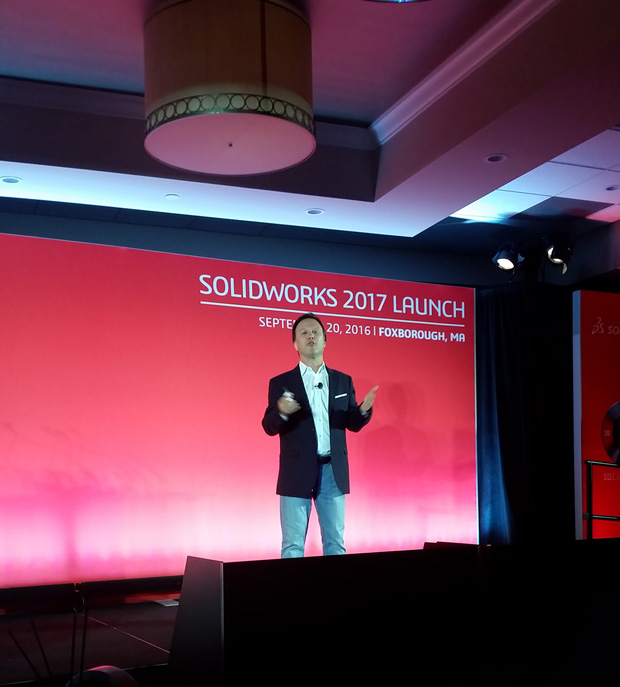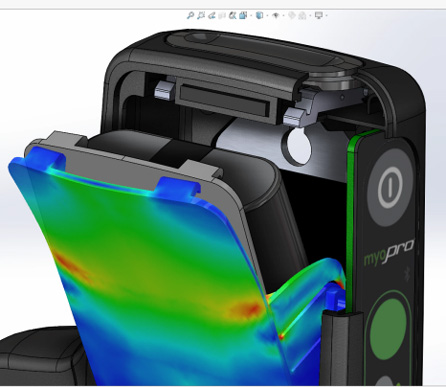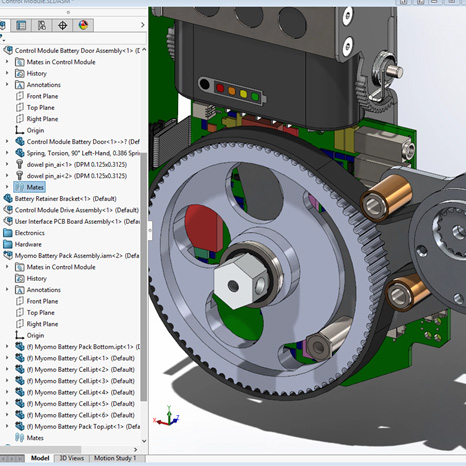
3D Interconnect lets users import third-party CAD files and have native modeling capabilities. Image courtesy of SOLIDWORKS.
Latest News
September 22, 2016
It’s tough to strike a balance when creating an engineering design software—companies either want to cater to all possible use cases, or give engineers the bare necessities. Describing SOLIDWORKS as “the swiss knife of engineering,” CEO Gian Paolo Bassi gave a glimpse of what to expect for 2017 at a launch event in Boston this week. “We want to bring [engineers] solutions dedicated to the toughest and most complicated projects,” Bassi explained. Beyond the addition of SOLIDWORKS PCB, which was announced earlier this year at SOLIDWORKS World, 2017 is bringing approximately 520 new features and enhancements across the board for design, simulation and data management.
Design Gets UI and UX Updates
Design is where everything begins, noted Kurt Anliker, worldwide director of Product Introduction. For 2017, updates have been made to the user interface to help decrease the number of mouse clicks needed during the design process. Breadcrumbs are now available as part of the cursor menu, “letting [users] work on their design right at their fingertips,” according to Anliker.
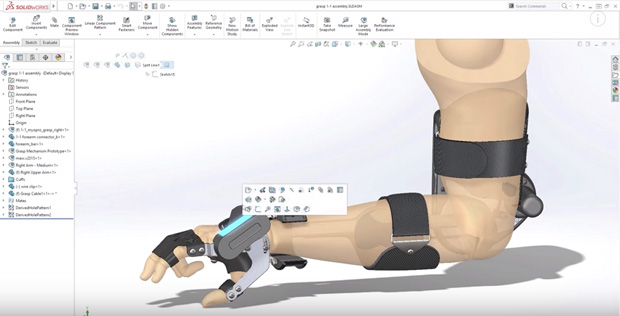 The updated user interface places more commands directly at the cursor. Image courtesy of SOLIDWORKS.
The updated user interface places more commands directly at the cursor. Image courtesy of SOLIDWORKS.Comments are also more integrated in the interface. This enables engineers to capture comments directly in the design, instead of through an outside PLM (product lifecycle management) or change order system.
The ability to create and smooth out edges is now cleaner, with 2017 eliminating the need for users to convert between chamfer, fillets and advanced hole specifications. Engineers can build everything they need for their design and holes from both sides with one user interface, Anliker explained.
Engineers are also quite literally gaining greater transparency in designs with the ability to see through parts and get new views during the design process.
In working with large assemblies, SOLIDWORKS 2017 users can setup libraries of assets with predefined mating conditions. This allows engineers to use drag-and-drop assembly mating, bypassing the need to join contact surfaces one at a time.
Increased Simulation and Validation
SOLIDWORKS 2017 is integrating more simulation capabilities with the introduction of stress hot spots, single-click study conversion and simulation static studies. The ability to do a greater number of stress studies is a feature of this release, so engineers have increased validation for their designs. Study comparison capabilities have also been updated.
While still under development, the company previewed Xdesign, a tool to help SOLIDWORKS users bring optimization into the design process. “We want to create a personal assistant to help users design better,” said Kishore Boyalakuntla, Brand UX and Product Portfolio Management senior director. The idea is that all of the optimization is automated—by simply plugging in specific shapes and loads, users can generate lighter, improved designs.
Collaborate with Users of Other Design Software
Interoperability is another issue addressed in this release. With the introduction of 3D Interconnect, files from Creo, Inventor and NX can be imported. It lets users directly open native third-party design data without translation, work directly with supplier and vendor CAD data, and preserve Face and Edge IDs during import. It is also change-aware, Anliker notes. So all design intent and geometry changes automatically update as needed.
 3D Interconnect lets users import third-party CAD files and have native modeling capabilities. Image courtesy of SOLIDWORKS.
3D Interconnect lets users import third-party CAD files and have native modeling capabilities. Image courtesy of SOLIDWORKS.SOLIDWORKS PDM gets a refresher in 2017 with expanded support for model-based definition through 3D PDFs and the ability to list native CAD files in the Vault check-in structure.
eDrawings, the free 3D model viewer associated with SOLIDWORKS, introduced an augmented reality function into its setup several years ago. Though not new, the feature will likely be put to more effective use with the current proliferation of affordable augmented reality (AR) hardware. eDrawings supports the use of Google Cardboard for AR, arguably the most affordable approach.
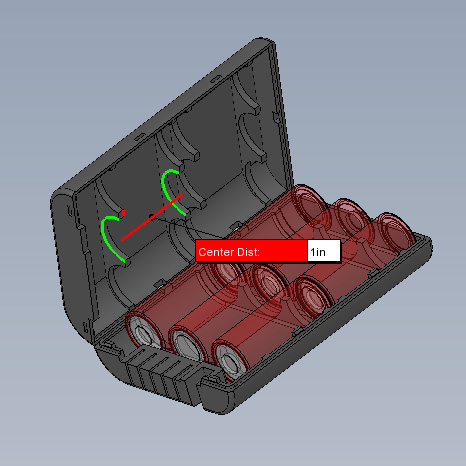 eDrawings lets users access data anywhere with mobile apps for iOS and Android devices. Image courtesy of SOLIDWORKS.
eDrawings lets users access data anywhere with mobile apps for iOS and Android devices. Image courtesy of SOLIDWORKS.A New Look at Licensing
Going into next year, SOLIDWORKS is expanding its licensing offerings with the availability of term licensing. This means a company could purchase a copy of SOLIDWORKS for a contract over several months without committing to a full year. Adding this flexibility lets organizations get access to the software for project-intense quarters.
Subscription customers will have access to additional online services, Boyalakuntla notes. This feature will give access to some features in the browser and updates as they are deployed throughout the year.
SOLIDWORKS’ move to subscription licensing follows precedent set by the likes of Autodesk, Siemens PLM Software and PTC. Small startups, engineering consultants and teams working on crowd-funded projects with fluctuating needs tend to favor subscription or short-term licensing. A decade ago, most CAD vendors were timid or reluctant to experiment with monthly and short-term licensing. They focused instead on the more predictable perpetual licensing for the lion’s share of their revenues. By now, most mainstream CAD vendors have embraced subscription—or some versions of short-term licensing—as a necessity.
Going Forward
In line with the theme of helping engineers tackle complex products, Bassi said SOLIDWORKS is launching “dedicated solutions for complex products. The solution is going to be a few clicks away.” These grouped toolsets are going to be offered in three main categories: optimization-driven design, integrated design to manufacturing and connected objects.
Where is the ‘A’ in computer-aided design? These solutions are about putting a big, bold and underline under that ‘A.’
Strategic partnerships are bolstering SOLIDWORKS’ features. Xively, an Internet of Things platform for connected devices, is adding tools into the connected objects offering. Xometry, an on-demand manufacturing service provider, is already helping users get part quotes and order them directly from within SOLIDWORKS.
“Where is the ‘A’ in computer-aided design? These solutions are about putting a big, bold and underline under that ‘A,’” Bassi said. “We want the computer to help you get to a solution,” “The future belongs to algorithms that can read ... information and make decisions.”
Algorithm-driven design or generative design used to be a specialty, part of high-end simulation and optimization packages used by experts. With products like Autodesk Within and Autodesk Inventor Shape Generator, Autodesk brought generative design into mainstream CAD usage. Additive manufacturing and affordable 3D printers also eliminated much of the barriers that previously made algorithm-driven design impossible or too costly to manufacturer. SOLIDWORKS’ initiatives in this area reinforce the growing appetite for generative design among novices and design engineers.
Additional reporting contributed by Kenneth Wong.
Subscribe to our FREE magazine, FREE email newsletters or both!
Latest News
About the Author
Jess Lulka is a former associate editor for Digital Engineering. Contact her via [email protected].
Follow DERelated Topics







